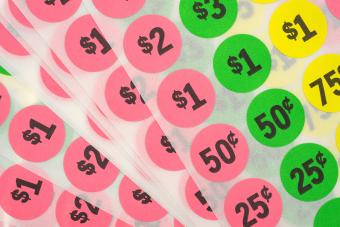
We could spend all day decorating a garage sale sign and organizing the items in an aesthetically pleasing way. But like you, we’d rather not have to fuss around with pricing. If you’re not a numbers kid, don’t worry. Learning how to price items for a garage sale isn’t rocket science, and you definitely won’t need a graphing calculator to figure out these numbers.
6 Tips to Help You Price Items at a Yard or Garage Sale
Setting up a garage sale seems like so much fun until you’re elbows deep into boxes of dusty stuff from the garage, and you’ve got no clue how much you should sell it for. Thankfully, pricing stuff for your yard or garage sale is much easier than you think. There are only a few guidelines you should follow.
1. Be Realistic About Your Area’s Average Income
When you’re holding a yard or garage sale, you have to be honest with yourself about what kind of disposable income the people in your area have. If you have a few heirloom pieces you want to get $50-$100 for, and you live in a lower income neighborhood, chances are that the people who stop by won't buy with those prices.
The point of a garage sale is to get rid of as much stuff as possible, and you can’t do that if you price higher than what your customers can spend.
2. Get an Idea of Average Prices With Online Sales
One of the best ways to get an idea of what stuff will go for is checking eBay for their sold listings. You can select it on any search by scrolling down the side menu and selecting to show only sold items.
Other sites, like Etsy, Mercari, and Facebook Marketplace, will give you an idea of what people are listing things for, but not what they’re actually selling for. Instead, always look for archives and sold listings and use them to get a ballpark range for how much some things should be worth.
3. Consider Every Item’s Condition
So much of how something is priced depends on how good of a condition it’s in. And while straight retail price isn’t a great standard to go off of, some people base their yard sale prices on 10% or more of the retail price. In theory, the better the condition something is in, the closer to retail price you can list it for.
Even if you don’t use a percent method, evaluate every item’s condition when considering what price you want to give it.
4. If You Hate Math, Create a Universal System

If you’re really using your garage or yard sale to spring clean and not to make a ton of money, then you can take a less particular approach to pricing. For all the math haters out there, this system is a godsend. Establish that everything has the same price, no matter what it is. You could start with $20 or $10, or even less if you just want to get rid of it.
5. Don’t Bother With Adding Cents
At garage sales, it’s $12.50 this and $4.42 that. From a buyer’s perspective, there’s nothing more frustrating than dealing with arbitrary cents amounts. So if you want to encourage people to buy more (and make things easier on your calculator), stick with dollar amounts. If buyers don’t have to run mental calculations over how much they owe you, they’ll probably walk away with a handful or two.
6. Make Room for Some Haggling
It doesn’t matter how confident you are about how you priced something, there’s always going to be someone walking up to the table asking if you’d take it for a lower price. Unlike online shopping, haggling is the name of the garage sale game. It’ll make your life a lot easier if you build in a little wiggle room.
For example, if you’d like to make about $12 to $15 on some vintage Fisher Price toys, then price the lot higher at $20 or $25. If someone is interested, they’ll probably ask if you could go down $5 or $10, which puts you at the profit margin you were hoping to get in the first place.
How to Stick the Landing at Every Garage Sale

There’s an art to running a successful yard or garage sale, and part of the magic is in learning the secret tricks for getting people to buy your stuff. If you’re hosting your first one or it has been a while, here are some must-know tips for sticking the landing every time.
- Group things together. People love feeling like they’re getting more for their money, so tossing in a few trinkets with one larger item for the same price will entice people to buy it.
- Put random things in bins. Some people like the thrill of discovery, so put some assorted things in boxes or bins for people to go through.
- Clearly mark everything. Every item needs to have one or two stickers with the price clearly listed. Whether you just want to color code or make full on tags is up to you.
Focus on Pricing to Sell
It’s so easy to get caught up in making a profit that you can forget what the point of hosting a yard sale or garage sale was in the first place. Since everything needs to go anyway, focus on pricing to sell. Your front yard isn’t an antiques store, and you shouldn’t set your prices like it is one.







